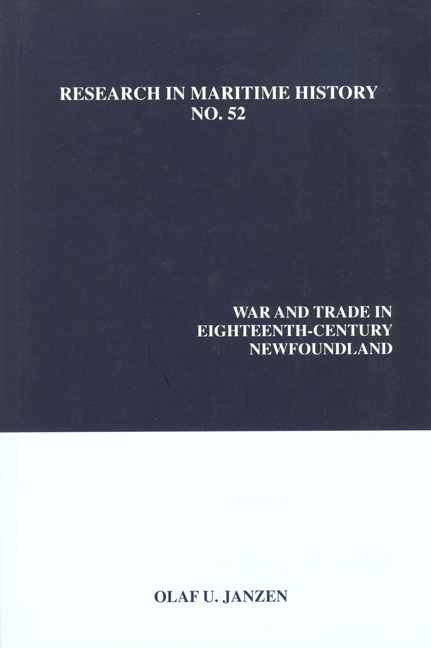Book contents
- Frontmatter
- Table of Contents
- About the Author
- Introduction
- “‘A World Embracing Sea:’ The Oceans as Highway, 1604-1815”
- “Of Consequence to the Service:' The Rationale behind Cartographic Surveys in Early Eighteenth-Century Newfoundland”
- “The Problem of Piracy in the Newfoundland Fishery in the Aftermath of the War of the Spanish Succession”
- “A Scottish Sack Ship in the Newfoundland Trade, 1726-1727”
- “'Une petite Republique' in Southwestern Newfoundland: The Limits of Imperial Authority in a Remote Maritime Environment”
- “The Illicit Trade in English Cod into Spain, 1739-1748”
- “Un Petit Dérangement: The Eviction of French Fishermen from Newfoundland in 1755”
- “The French Raid upon the Newfoundland Fishery in 1762: A Study in the Nature and Limits of Eighteenth-Century Sea Power”
- “Showing the Flag: Hugh Palliser in Western Newfoundland, 1763-1766”
- “The Royal Navy and the Interdiction of Aboriginal Migration to Newfoundland, 1763-1766”
- “The Royal Navy and the Defence of Newfoundland during the American Revolution”
- “The American Threat to the Newfoundland Fisheries, 1776-1777”
- Appendix
“The French Raid upon the Newfoundland Fishery in 1762: A Study in the Nature and Limits of Eighteenth-Century Sea Power”
- Frontmatter
- Table of Contents
- About the Author
- Introduction
- “‘A World Embracing Sea:’ The Oceans as Highway, 1604-1815”
- “Of Consequence to the Service:' The Rationale behind Cartographic Surveys in Early Eighteenth-Century Newfoundland”
- “The Problem of Piracy in the Newfoundland Fishery in the Aftermath of the War of the Spanish Succession”
- “A Scottish Sack Ship in the Newfoundland Trade, 1726-1727”
- “'Une petite Republique' in Southwestern Newfoundland: The Limits of Imperial Authority in a Remote Maritime Environment”
- “The Illicit Trade in English Cod into Spain, 1739-1748”
- “Un Petit Dérangement: The Eviction of French Fishermen from Newfoundland in 1755”
- “The French Raid upon the Newfoundland Fishery in 1762: A Study in the Nature and Limits of Eighteenth-Century Sea Power”
- “Showing the Flag: Hugh Palliser in Western Newfoundland, 1763-1766”
- “The Royal Navy and the Interdiction of Aboriginal Migration to Newfoundland, 1763-1766”
- “The Royal Navy and the Defence of Newfoundland during the American Revolution”
- “The American Threat to the Newfoundland Fisheries, 1776-1777”
- Appendix
Summary
On 8 May 1762, four French warships slipped out of Brest in thick weather and eluded blockading British cruisers. On board were 560 soldiers and officers under the command of Joseph-Louis-Bernard de Cléron, comte d'Haussonville. Most of the men believed that their destination was Saint- Domingue, France's only remaining possession in the West Indies, the rest having been captured by British forces. Not until they had reached the open sea did the expedition's commander, Chef d'escadre Charles-Henri-Louis d'Arsac, chevalier de Ternay, reveal their true objective: the destruction of British trade and commerce in the North Atlantic, beginning with the British fishery at Newfoundland.
The choice of this objective said a great deal about France's situation by that point in the Seven Years’ War. For over four years, it had suffered a nearly unremitting series of defeats which left much of its colonial empire in enemy hands, its navy in a shattered condition and its financial and material ability to continue the war very much impaired. Yet attempts to negotiate an end to the war had ended in failure; when the government of William Pitt had refused to satisfy the minimum French demands concerning the fishery in the Gulf of St. Lawrence and at Newfoundland, the French broke off negotiations. That had been in September 1761. The duc de Choiseul, who was then minister of marine, of war and of foreign affairs, had to find some way of pressuring the British into a more reasonable attitude. On the diplomatic side, this would mean bringing Spain (with whom France had concluded an alliance in August) into the war. On the strategic side, it would mean continuing operations against England's maritime empire. Since France's ability to conduct operations was by then quite limited, the campaign for 1762 would have to be planned with careful attention to the selection of the objectives, the organization of the expedition and the appointment of the officers whose responsibility it would be to carry out the mission.
The Plan de Campagne par Mer pour l'Annee, 1762, which Choiseul read and endorsed during the winter of 1761-1762, probably provided the inspiration for Teraay's mission. It recommended raids against Brazil (a possession of England's ally, Portugal), the British fishery at Newfoundland and British trade along the European and West African coasts.
- Type
- Chapter
- Information
- War and Trade in Eighteenth-Century Newfoundland , pp. 129 - 154Publisher: Liverpool University PressPrint publication year: 2013



